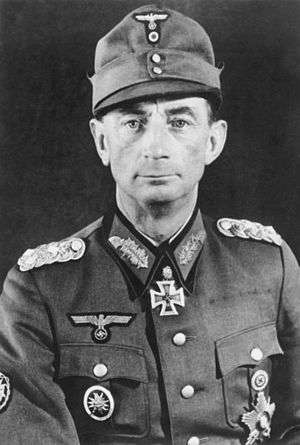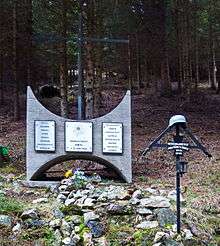Eduard Dietl
| Eduard Dietl | |
|---|---|
 | |
| Born |
21 July 1890 Bad Aibling, Kingdom of Bavaria, German Empire |
| Died |
23 June 1944 (aged 53) near Rettenegg, Reichsgau Steiermark, Nazi Germany |
| Buried | Nordfriedhof (Munich) |
| Allegiance |
|
| Years of service | 1910–44 |
| Rank | Generaloberst |
| Commands held | 20th Mountain Army |
| Battles/wars | |
| Awards | Knight's Cross of the Iron Cross with Oak Leaves and Swords |
Eduard Dietl (21 July 1890 – 23 June 1944) was a German general during World War II who commanded the 20th Mountain Army. He was a recipient of the Knight's Cross of the Iron Cross with Oak Leaves and Swords of Nazi Germany.
Military career
Born in 1890, Dietl joined the army on 1 October 1909 as a Fahnenjunker in the 5th Infantry Regiment "Grand Duke Ernst Ludwig of Hesse" of the Bavarian Army in Bamberg. In the World War I, he was deployed on the Western Front in which he was wounded twice in October 1914 and October 1918. During the Weimar Republic, he joined the Deutsche Arbeiter Partei and the paramilitary group Freikorps of Franz Ritter von Epp in 1919.[1] Dietl continued to serve in the German Army and, as a Generalmajor, he helped organise the 1936 Winter Olympics held at Garmisch-Partenkirchen.[2]
Dietl commanded the German 3rd Mountain Division that participated in the German invasion of Norway on 9 and 10 April 1940. Most of this division was landed at Narvik by a German naval force of ten destroyers, commanded by Commodore Friedrich Bonte, on 9 April 1940. British naval forces led by the battleship HMS Warspite destroyed all ten destroyers that had ferried Dietl's troops to Narvik and managed to recapture the town. Dietl's mountaineers withdrew into the hills and later retook the town when Britain abandoned her efforts to evict the Germans from Norway due to German success on the Western Front (the Franco-German border, Luxembourg, Belgium and the Netherlands).
Dietl was sent to Finland designated to be the "Hero in the snow" (to be a counterpart to Rommel who would be the "Hero in the sun", also given a secondary theater leaving the main stage to Hitler).[3] A convinced Nazi and one of Hitler's favourite generals, he was the first German soldier to receive, on 19 June 1940, the oak leaves cluster to the Knight's Cross of the Iron Cross. Dietl was also popular among his men and his Finnish allies.[4]
Dietl subsequently commanded German forces in Norway and northern Finland and in Eastern Europe and rose to the rank of Generaloberst, commanding the 20th Mountain Army on the northern Eastern Front, where the results of the German Arctic campaign were disappointing. Dietl initially turned down his promotion, but was convinced to accept the appointment by Generaloberst Alfred Jodl.[4] On 23 June 1944, Dietl, along with generals Thomas-Emil von Wickede, Karl Eglseer and four other passengers, was killed in an air crash in Austria. The Ju 52 aircraft carrying Dietl, General der Infanterie Thomas-Emil von Wickede, age 51, General der Gebirgstruppe Karl Eglseer, age 53, Generalleutnant der Gebirgstruppe Franz Rossi and three other passengers crashed in the vicinity of the small village of Rettenegg, Styria. There were no survivors.
Until 1997, the municipality of Ringelai in the Bavarian Forest honored Dietl with a memorial plaque. Until 1977, this site had honored Albert Leo Schlageter instead.[5] Freyung honored Dietl with a General-Dietl-Straße.[6]
Awards

- Prince Regent Luitpold Medal (Bavaria; 12 March 1911)[7]
- Iron Cross (1914) 2nd class (16 September 1914) & 1st class (3 September 1916)[7]
- General Honour Decoration (Hesse) (16 October 1915)[7]
- Wound Badge (1914) in Silver (1917)[7]
- Bavarian Military Order of Merit 4th class with Swords (18 June 1918) & Commanders Cross (17 August 1933)[7]
- Honour Cross of the World War 1914/1918 (18 January 1935)[7]
- Wehrmacht Long Service Award, 4th class with 1st class (2 October 1936)[7]
- Clasp to the Iron Cross (1939) 2nd class (24 September 1939) & 1st class (15 April 1940)[7]
- Destroyer War Badge (5 November 1940)[7]
- Narvik Shield (21 March 1941)[7]
- Knight's Cross of the Iron Cross with Oak Leaves and Swords
- Knight's Cross as Generalleutnant and commander of the 3. Gebirgs-Division (9 May 1940)[8]
- 1st Oak Leaves as Generalleutnant and commanding general of the Gebirgs-Korps Norwegen (19 July 1940)[8]
- Swords as Generaloberst and commander in chief of the 20. Gebirgs-Armee (1 July 1944, posthumously)[8]
- Pilot/Observer Badge in Gold with Diamonds(5 January 1941)[7]
- Order of Merit, Commander's Cross with carry permit (Chile; 16 March 1934)[7]
- Order of the White Rose, Grand Cross with Breast Star and Swords (Finland; 9 November 1941)[7]
- Order of the Cross of Liberty 1st class with Star, Oak leaves and Swords (20 January 1944) & Grand Cross (Finland; 28 June 1944)[7]
References
Citations
- ↑ Hürter, Johannes (2007). Hitlers Heerführer. Die deutschen Oberbefehlshaber im Krieg gegen die Sowjetunion 1941/42. 2nd edition (in German). Oldenbourg, Munich. p. 624-625. ISBN 978-3-486-58341-0.
- ↑ "NORTHERN THEATRE: Indestructible Dietl". Time Magazine. 10 June 1940.
- ↑ Latimer, Jon (2001). Tobruk 1941: Rommel's Opening Move. Oxford: Osprey Military. p. 27. ISBN 978-1-84176-092-6.
- 1 2 Lunde 2011, p. 145.
- ↑ Anna Rosmus Hitlers Nibelungen, Samples Grafenau 2015, pp. 228f.
- ↑ Anna Rosmus Hitlers Nibelungen, Samples Grafenau 2015, p. 229.
- 1 2 3 4 5 6 7 8 9 10 11 12 13 14 Thomas & Wegmann 1993, p. 85.
- 1 2 3 Scherzer 2007, p. 272.
Bibliography
- Lunde, Henrik O. (2011). Finland's War of Choice. Casemate Publishers, ISBN 978-1-935149-48-4.
- Scherzer, Veit (2007). Die Ritterkreuzträger 1939–1945 Die Inhaber des Ritterkreuzes des Eisernen Kreuzes 1939 von Heer, Luftwaffe, Kriegsmarine, Waffen-SS, Volkssturm sowie mit Deutschland verbündeter Streitkräfte nach den Unterlagen des Bundesarchives [The Knight's Cross Bearers 1939–1945 The Holders of the Knight's Cross of the Iron Cross 1939 by Army, Air Force, Navy, Waffen-SS, Volkssturm and Allied Forces with Germany According to the Documents of the Federal Archives] (in German). Jena, Germany: Scherzers Militaer-Verlag. ISBN 978-3-938845-17-2.
- Thomas, Franz; Wegmann, Günter (1993). Die Ritterkreuzträger der Deutschen Wehrmacht 1939–1945 Teil VI: Die Gebirgstruppe Band 1: A–K [The Knight's Cross Bearers of the German Wehrmacht 1939–1945 Part VI: The Mountain Troops Volume 1: A–K] (in German). Osnabrück, Germany: Biblio-Verlag. ISBN 978-3-7648-2430-3.
- Thomas, Franz (1997). Die Eichenlaubträger 1939–1945 Band 1: A–K [The Oak Leaves Bearers 1939–1945 Volume 1: A–K] (in German). Osnabrück, Germany: Biblio-Verlag. ISBN 978-3-7648-2299-6.
- Williamson, Gordon; McGregor, Malcolm (2005). German commanders of World War II. 1, Army. Oxford, UK: Osprey Publishing. ISBN 978-1-84176-596-9.
| Military offices | ||
|---|---|---|
| Preceded by none |
Commander of 3. Gebirgs-Division 1 May 1938 – 14 June 1940 |
Succeeded by General der Gebirgstruppen Julius Ringel |
| Preceded by none |
Commander of Gebirgs-Armeekorps Norwegen 14 June 1940 – 15 January 1942 |
Succeeded by Generalfeldmarschall Ferdinand Schörner |
| Preceded by Generaloberst Nikolaus von Falkenhorst |
Commander of Lappland Armee 15 January 1942 – 20 June 1942 |
Succeeded by redesignated as 20. Gebirgs-Armee |
| Preceded by none |
Commander of 20. Gebirgs-Armee 20 June 1942 – 23 June 1944 |
Succeeded by Generaloberst Dr. Lothar Rendulic |